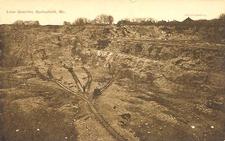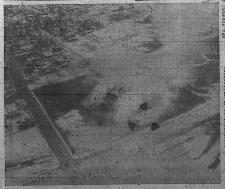Marblehead Lime Company
 Marblehead Lime works are branching out
Marblehead Lime works are branching out
Springfield Leader-Democrat; March 22, 1899
"There is vast wealth in the stone resources of the country surrounding Springfield and fortunes are to be made by development. An instance of the importance of this branch of industry is to be found in the case of the Marblehead Lime Works on Phelps Avenue.
"The business of the Marblehead Company has grown to such an extent that extensive improvements and expansion of the plant have become necessary. Limestone is not the only kind of stone to be found in this region. There is plenty of other varieties that could be utilized in buildings and in making sidewalks.
"Out at the Marblehead works a score or more men are employed in building a stone power house, 30 by 40 feet, which will be equipped with a 90-horse power engine. The constantly increasing business of the lime company is the occasion for building the power house, as increased facilities for handling the product of the quarry have become a necessity. Another new addition to the equipment is a large 14-inch suction pump to run by steam. Water has been struck, and the deeper the workmen quarry for the stone out of which the lime is made, the stronger becomes the stream of water. So it is necessary to either expand the quarry surface or pump the water so that the excavation at its present dimensions may be deepened. As there seems to be no end to the depth of the stone formation, it has been decided to remove the water and keep on going deeper.
"The improvements now being made by the Marblehead Company mean an expenditure of about $6,000, but that is no more than the company has been in the habit of investing annually, for since it took charge of the lime works five years ago, the entire plant has practically been rebuilt and there has been notable expansion in various directions. This has been accomplished a little at a time by degrees, without any blare of trumpets. The lime works now employ about 60 men, and it is expected that additions to the force will soon be necessary. Springfield lime is shipped to nearly all the large cities of the country. When the Marblehead Company took charge of the plant five years ago the output was 25,000 barrels annually. Last year it was 120,000 barrels, and the output for the present year will probably reach 150,000 barrels. The capacity of the plant is 600 barrels daily. Superintendent J. W. Kelso says business in his line is brisk and he thinks the outlook for future growth is encouraging."
 From a 1973 article in the News-Leader, titled "History of Hole in Ground", the earliest history of the quarry was not clear. James H. Smith built a kiln at the junction of the St. Louis and San Francisco and the Kansas City, Fort Scott and Memphis lines. Smith sold one-half interest in the kiln to J. G. Schermerhorn shortly thereafter, and another kiln was added when J. S. Atkinson purchased an interest and the Springfield White Lime Association was formed. New kilns were added in 1885 and 1886 and the company was sold in 1894 to the Marblehead Lime Company of Chicago. In 1941 the Ash Grove Lime Company purchased the Marblehead properties and continued to operate on the downtown location until 1963. At one time they operated nine kilns on the 15-acre tract west of the quarry. They ceased taking rock out of the quarry in 1946. The quarry was abandoned in 1963 and the following year it was opened as a sanitary landfill for trade wastes. The landfill operated until 1973 when fire broke out.
From a 1973 article in the News-Leader, titled "History of Hole in Ground", the earliest history of the quarry was not clear. James H. Smith built a kiln at the junction of the St. Louis and San Francisco and the Kansas City, Fort Scott and Memphis lines. Smith sold one-half interest in the kiln to J. G. Schermerhorn shortly thereafter, and another kiln was added when J. S. Atkinson purchased an interest and the Springfield White Lime Association was formed. New kilns were added in 1885 and 1886 and the company was sold in 1894 to the Marblehead Lime Company of Chicago. In 1941 the Ash Grove Lime Company purchased the Marblehead properties and continued to operate on the downtown location until 1963. At one time they operated nine kilns on the 15-acre tract west of the quarry. They ceased taking rock out of the quarry in 1946. The quarry was abandoned in 1963 and the following year it was opened as a sanitary landfill for trade wastes. The landfill operated until 1973 when fire broke out.
The fire burned for several weeks in 1973 and then flared up again in 1976. For many years the quarry pit was full of water. In 2001, the quarry was drained and filled to become the Commons of Jordan Valley Park. Above right is an ariel photograph of the fire in 1973.
Find this article at http://thelibrary.org/blogs/article.cfm?aid=4194&lid=62